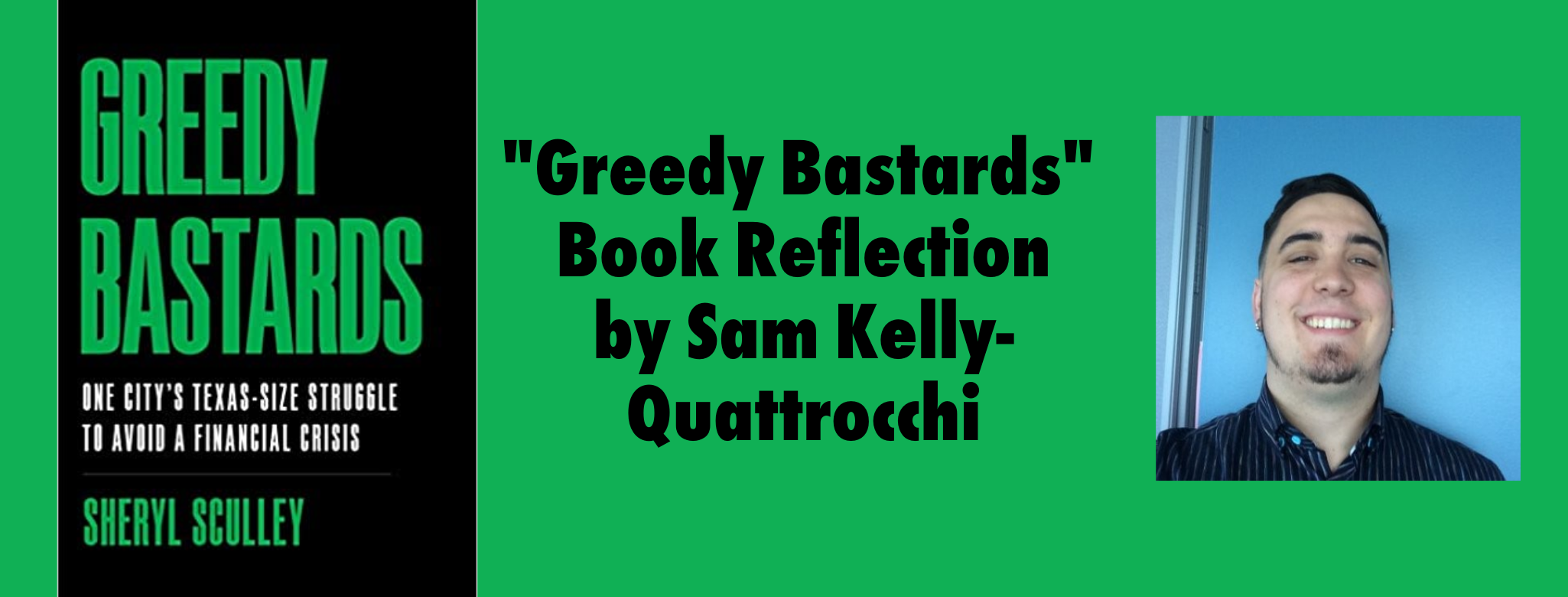
On January 21, 2021, ELGL members will discuss “Greedy Bastards” by Sheryl Scully at the ELGL Book Club. We gave away six signed copies of the book to our members and asked them to write reflections on the book. Here’s the reflection post by Sam Kelly-Quattrocchi, finance analyst for the City of Springfield, OR. Connect with Sam on LinkedIn.
After hearing the name and reading the synopsis, I had assumed Sheryl Sculey’s book, Greedy Bastards, would be the Avengers: Endgame of local government stories. Epic battles and characters, that while enjoyable and exciting, would not have much bearing on my work in local government. Yet, as I read more about the multitude of challenges faced by Sheryl and her team in San Antonio, I was continually amazed at the parallels I could draw to my small city in Oregon. While the crux of this story is the contentious rewriting of the Fire and Police union contracts, San Antonio, like all cities, is at any given time facing a multitude of issues across various departments. These include community relations, and employee satisfaction, balancing the City’s fiscal responsibility to the community and still providing the necessary services. After reading this book several themes resonate with me including: leading with compassion, creating the team around you, and community involvement.
Even in my short time working in local government, I have found myself surrounded by people with a passion for helping others. While some folks joke about the great benefits and cushy pension plans, that model is becoming a relic of the past as local governments strive to find financially sound ways to serve their community. This has led to cohorts of government employees more dedicated to serving their community and leading with compassion. Sheryl’s work in San Antonio was always focused on ways to better serve the citizens of the city, even if it meant cutting benefits to a group of employees.
During various meetings and negotiations, Sherly continually came back to the idea of doing what was ultimately best for the health of the entire City. While the police and fire certainly enjoyed their benefits, and employee happiness is essential for a working government, the financial costs greatly outweighed the benefits when looking at the long term health of the city. By framing these issues with compassion for the city, and not a condemnation of the police and fire employees, Sherly guaranteed the work was always moving the health and well being of the city forward.
Along with leading compassionately, Sherly hammered the importance of having the right people with them at the right time. They listed a wide variety of people that they helped hire, train, promote, and in some cases pass on to serve other communities. Identifying highly skilled and motivated employees early on positioned the City of San Antonio to engage in complicated, and lengthy policy and process negotiations and improvements. These were not simple problems with simple solutions, but far-reaching issues that required the support of the city employees, the elected officials, and the citizens of San Antonio. Building a strong coalition also requires forward-thinking in ensuring a successful plan is created and updated as the needs of the city changed. The baby boomer generation is entering into retirement and governments will have to prepare for numerous retirements across all levels and divisions of their teams. By creating and following through with success planning, employers can better prepare themselves to survive and hopefully thrive, through a period of high change.
Lastly, Sheryl’s ability to tackle systemic issues within the City of San Antonio was not accomplished solely with the power of her local government team but required involvement from the community. Throughout the book, Sherly mentions various citizen and community panels they created to increase transparency and make sure the voices of all citizens were being heard. This involvement helped build a better relationship between the city manager and the citizens she served so that when she came forward with modern updates to systemic problems, the citizens could trust these changes were coming from a reliable leader. Sometimes being allowed to present and share concerns with committees and councils can be one of the largest hurdles. How are these groups to know what issues are the most important? By building a relationship with the community, Sheryl’s name and her proposals came with the benefit of the doubt and let everyone know the compassion and sound judgment these proposals were built around.
The challenges Sheryl faced, and the solutions implemented, while utilized in a large city have important lessons for governments at all levels. Finance challenges surrounding employee benefits, the strong power of unions, team building, and succession planning are all key issues governments need to be continually examining. There is no one solution that will forever solve these issues, but a revolving door of people and ideas that need to be examined and actualized. While the movie Avengers: Endgame came to a, somewhat satisfactory, conclusion, our work will never be that simple or that clear-cut. In wrapping up her book, Sherly offers a plethora of advice, though for me one line sticks out in particular “one step at a time.” At all levels of government, we will be faced with challenges and issues, some we were prepared for, others will surprise us. But by taking them one step at a time, even those most complicated and systemic problems can be tackled.
